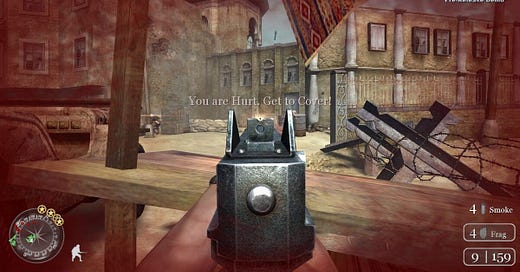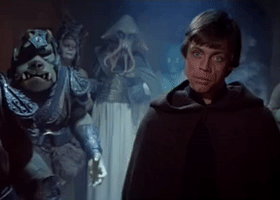Regenerating Health in Video Games and Hit Point Inflation in D&D
How my heroic fantasy ttrpg takes inspiration from the history of video game design
The way people play d&d has changed a lot since the 70s, but the rules haven’t always kept pace with the culture.
The core mechanics of 5e have their origins in wargaming, dungeon-crawling, and old school methods of play. But many people, myself included, have played 5e in a heroic style. The same ruleset, but for a totally different genre and style of play.
So now, in designing my own heroic fantasy ttrpg, I approached the mechanic of hit points in a new way, taking inspiration from the history of video games.
I’m Colin, and I’m a professional video game designer. This is Drolleries, where I write about d&d, ttrpgs, and game design.
Looking to Video Games
For a more in-depth discussion of health systems throughout video games, check out this video by Mark Brown from Game Maker’s Toolkit.
In older first-person shooters, damage is mostly avoidable. In Doom, projectiles are slow-moving, able to be dodged, and melee enemies are meant to apply pressure for you to keep moving. Hitscan enemies aren’t ubiquitous, and you can even avoid getting hit by making sure you’ve positioned a different enemy between you and the hitscan ones. As a result, the damage you take in any given encounter is mostly a measure of how well you played. Damage represents a specific mistake you made, something you could have avoided if you had better tactics or dexterity.
As shooters evolved, and as the settings became more modern, hitscan enemies became more common, so damage became unavoidable. It was no longer true that you could avoid all damage if you played well enough. To compensate, regenerating health systems became more common.
In these systems, your health recovers either partially or fully after a period of not taking damage. You can theoretically take infinite damage throughout an encounter, as long as it’s not all at once. This lets players charge into fire temporarily to reposition or kill a high-priority target, as long as they’re not in the line of fire for too long. It creates an ebb and flow to the pacing as the player takes damage then runs to a safe position to recover.
OSR to Heroic - Evolving Styles of Play
TTRPGs have gone through a similar evolution. In old-school games, from Basic D&D to modern OSR games like Knave, Cairn, and Shadowdark, combat is considered a failure state. Players are encouraged to be creative and think of alternate ways to bypass encounters. Either by moving fast through a dungeon to avoid wandering monster checks, or by using valuable spells like Sleep to neutralize an enemy, or by only engaging in unfair fights where the players have a numbers advantage or surprise, players are encouraged to avoid combat at all costs because of how deadly it is.
Like as in Doom, damage you take in old-school games is a measure of how well you’ve played.
But as heroic styles of play became more common in fantasy games, with 3e, Pathfinder, 4e, 5e, and now Daggerheart and Draw Steel, the paradigm has shifted. Damage is expected because engaging in combat is part of the fun of the game. We expect players will fight the villains in epic encounters. Player characters want to use all the cool powers they get from leveling up and getting magic items.
In heroic games, the measure of whether you “succeeded” or “failed” a combat encounter is not if a PC died, or even if a PC took damage, it’s if the PCs took more damage than is expected from the relative difficulty level of the encounter. That fuzzy line is where the drama in heroic games comes from. The players can keep themselves above that line with good preparation, tactics, and teamwork, but if they play badly, the combat will drag on longer, and the players will take more damage than the game’s encounter math expects them to.
This is what has led to the so-called “inflation” of hit points. With the randomness of rolling dice for attacks, damage, and saves, the numbers have to be large enough to soak up that randomness and balance it with the predictable heuristics of good play. If the players play well, either through good tactics and teamwork or by managing their resources smartly, one bad damage roll shouldn’t totally screw the PCs.
However, even with the inflation of hit points, the health system in many modern games is still fundamentally a system of attrition. Players have a fixed number of hit points to spend throughout the day, and this creates certain player behaviors that don’t feel heroic. In 5e, players will often want to rest after a difficult encounter before continuing the story and risking another fight. But this isn’t very heroic. When Cap or Iron Man get beat up really badly, it only makes them more persistent, more willing to keep fighting, even if they are severely wounded.
New games that embrace this heroic feel have their own solutions for this. In Draw Steel, your character gets stronger after each encounter, making it a risk-reward decision whether to press on or stop for a 24-hour respite (during which, the villain’s plans move forward). And in Daggerheart, individual players’ reserves of Hope rise and fall, so players may not agree when resting is worth it, especially because the GM gains Fear if the players stop for a short or long rest.
However, neither of these actually change the underlying attrition of hit points throughout an adventuring day; they just add additional motivations for players to avoid resting.
This is what I tried to change with my system.
Stamina in My Heroic Fantasy TTRPG
In my heroic fantasy game I’m designing, I want the system to encourage players to act heroically and take risks. They should want to engage in combat because it’s fun and fast. But a fight goes badly, either because they’re outmatched or because they played badly or because the dice just went against them, it should be a significant moment that affects the story going forward.
When Iron Man fights some bad guys and it goes badly, he doesn’t immediately die, he’s just wounded for some time, which affects how he approaches future situations. I want those story-focused consequences of “losing” a fight that still encourage players to push forward and engage in epic, heroic fights where they aren’t afraid of dying undramatically without warning.
Here’s how my system works.
Each hero has stamina, ranging from 4-7 based on your class & build. Your stamina resets after each encounter.
When an enemy attacks you, you lose 1-2 stamina based on the attack’s power. If you hit 0, you take a wound, then you regain all your stamina. Wounds give you a significant penalty to rolls with a specified stat until treated.
If you already have 3 wounds and you drop to 0 stamina, you die (or possibly make a death move a la Daggerheart, because my group has been loving the options for death since the beta playtest).
Similar to regenerating health in video games, small amounts of damage don’t affect the characters. It’s only when they take too much at once that the consequences start to stack up.
This encourages players to take more risks in combat and to work together. To maximize their effectiveness and avoid taking wounds, players need to spread the damage between them. When I playtested this with my group, it created many cool tactical moments that also serve to trade the spotlight between players.
This also creates clear consequences of success and failure in a combat. Rather than players having to estimate the fuzzy heuristic of if they took more damage than was expected for that encounter’s challenge rating, the outcome of taking a wound or not is very clear, and it has an impact on the story. In 5e, you either die or you don’t, which isn’t very interesting. Even if you “fail” a combat encounter early in the adventuring day, you probably have enough hit points overall that nothing actually happens.
In my system, all combats have consequences for failure, but death is only on the table if you’ve failed many fights in a row and taken multiple wounds.
More About My TTRPG
If you’d like to read more about the ongoing development of my ttrpg, check out these articles:
Better Social Stats in Fantasy TTRPGs
Imagine this scenario. You’re running a game of d&d, and your PCs are a heavily armored knight, a shifty-looking cloaked ranger, and a colorfully dressed musician holding a lute. All three of them walk into the crime lord’s underground base to negotiate a hostage situation. Who’s doing the talking?
Out With the Action Economy
After I ran combat in Daggerheart, I couldn’t go back to tracking initiative.
In Daggerheart, there is no initiative, no turn order. Any player is free to take any action in combat, but if they fail an attack roll or roll with Fear, it becomes the GM’s turn. On the GM’s turn, they can activate monsters loosely based on how many actions the players have taken.









Like this a lot, I think Stamina is a really interesting resource to play with.
Forgive me if this was in the article and I missed it, how does Stamina recover? Is it like a video game where it resets after combat automatically?
I wonder whether a 'recover' action might be fun. Any character could take cover, take a breath and recover some Stamina before charging back in.
Good write up. One of the things we see in TTRPGs that are not cut from D&D DNA is armor/toughness being not a measure of how hard you are to hit but how much damage you can soak. A too wound threshold if you will.